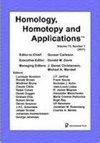振幅、同调和惠特尼扭转
IF 0.5
4区 数学
Q2 MATHEMATICS
引用次数: 0
摘要
振幅是度量空间和图的数值不变量,在精确意义上类似于欧拉特征。振幅同调是一种代数不变量,用于对振幅进行分类。我们从同调的角度解释了在惠特尼扭转下量级的不变性,扩展了之前已知的结果,使其涵盖了更广泛的胶合类别。这不仅为计算幅值提供了一个新工具,也是第一个使用幅值同调来证明幅值的新定理。本文章由计算机程序翻译,如有差异,请以英文原文为准。
Magnitude, homology, and the Whitney twist
Magnitude is a numerical invariant of metric spaces and graphs, analogous, in a precise sense, to Euler characteristic. Magnitude homology is an algebraic invariant constructed to categorify magnitude. Among the important features of the magnitude of graphs is its behaviour with respect to an operation known as the Whitney twist.We give a homological account of magnitude’s invariance under Whitney twists, extending the previously known result to encompass a substantially wider class of gluings. As well as providing a new tool for the computation of magnitudes, this is the first new theorem about magnitude to be proved using magnitude homology.
求助全文
通过发布文献求助,成功后即可免费获取论文全文。
去求助
来源期刊
CiteScore
1.10
自引率
0.00%
发文量
37
审稿时长
>12 weeks
期刊介绍:
Homology, Homotopy and Applications is a refereed journal which publishes high-quality papers in the general area of homotopy theory and algebraic topology, as well as applications of the ideas and results in this area. This means applications in the broadest possible sense, i.e. applications to other parts of mathematics such as number theory and algebraic geometry, as well as to areas outside of mathematics, such as computer science, physics, and statistics. Homotopy theory is also intended to be interpreted broadly, including algebraic K-theory, model categories, homotopy theory of varieties, etc. We particularly encourage innovative papers which point the way toward new applications of the subject.

 求助内容:
求助内容: 应助结果提醒方式:
应助结果提醒方式:


